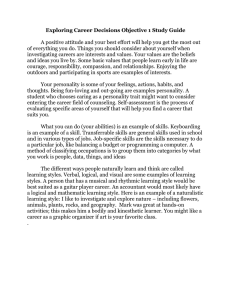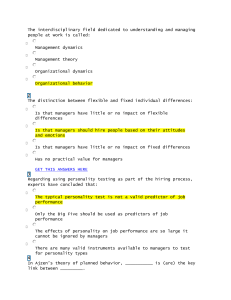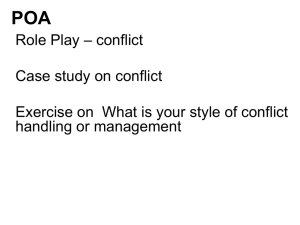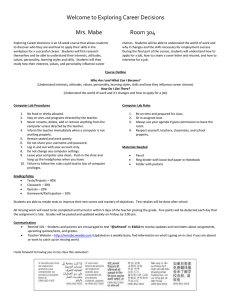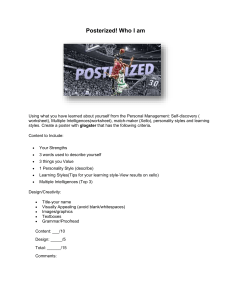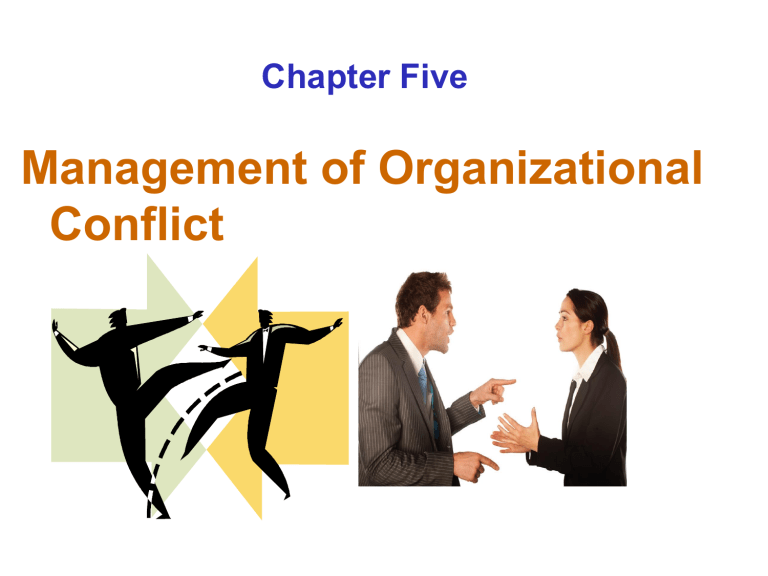
Chapter Five Management of Organizational Conflict Chapter Outlines •Nature and scope of conflict •Functional and dysfunctional conflict •Causes of conflict •Types of conflict •Conflict process/stages of conflict •Conflict management methodologies/Conflict resolution Model Conflict Conflict Defined – A process that begins when one party perceives that another party has negatively affected, or is about to negatively affect, something that the first party cares about – Encompasses a wide range of conflicts that people experience in organizations • Incompatibility of goals • Differences over interpretations of facts • Disagreements based on behavioral expectations Transitions in Conflict Thought Traditional View of Conflict The belief that all conflict is harmful and must be avoided Causes • Poor communication • Lack of openness • Failure to respond to employee needs Transitions in Conflict Thought (cont’d) Human Relations View of Conflict The belief that conflict is a natural and inevitable outcome in any group Interactionist View of Conflict The belief that conflict is not only a positive force in a group but that it is absolutely necessary for a group to perform effectively Causes of Conflict According to both Daft and Terry, several factors may create organizational conflict. They are as follows: •Scarce Resources- Resources may include money, supplies, people, or information. Often, organizational units are in competition for scarce or declining resources •Jurisdictional Ambiguities- Conflicts may also surface when job boundaries and task responsibilities are unclear. Individuals may disagree about who has the responsibility for tasks and resources •Personality Clashes -A personality conflict emerges when two people simply do not get along or do not view things similarly. Personality tensions are caused by differences in personality, attitudes, values, and beliefs. Causes of Conflict • Power and Status Differences- Power and status conflict may occur when one individual has questionable influence over another. People might engage in conflict to increase their power or status in an organization. •Goal Differences -Conflict may occur because people are pursuing different goals. Goal conflicts in individual work units are a natural part of any organization •Communication Breakdown- barriers may be derived from differences in speaking styles, writing styles, and nonverbal communication styles. Functional versus Dysfunctional Conflict Functional Conflict (Positive) Conflict that supports the goals of the group and improves its performance Dysfunctional Conflict (Negative) Conflict that hinders group performance Types of conflict on the basis of its nature •Intra-personal Conflict (value and decision making conflict) •Inter-personal Conflict •Intra-Group Conflict •Inter-Group Conflict •Intra-Organizational Conflicts (Horizontal and Vertical Conflict) •Inter-Organizational Conflict Stage I: Potential Opposition or Incompatibility Communication – Semantic difficulties, misunderstandings, and “noise” Structure – – – – – – Size and specialization of jobs Jurisdictional clarity/ambiguity Member/goal incompatibility Leadership styles (close or participative) Reward systems (win-lose) Dependence/interdependence of groups Personal Variables – Differing individual value systems – Personality types Stage II: Cognition and Personalization Perceived Conflict Felt Conflict Awareness by one or more parties of the existence of conditions that create opportunities for conflict to arise Emotional involvement in a conflict creating anxiety, tenseness, frustration, or hostility Conflict Definition Negative Emotions Positive Feelings Stage III: Intentions/Conflict management methodologies Intentions Decisions to act in a given way Cooperativeness • Attempting to satisfy the other party’s concerns Assertiveness • Attempting to satisfy one’s own concerns Dimensions of Conflict-Handling Intentions /Conflict management methodologies Source: K. Thomas, “Conflict and Negotiation Processes in Organizations,” in M.D. Dunnette and L.M. Hough (eds.), Handbook of Industrial and Organizational Psychology, 2nd ed., vol. 3 (Palo Alto, CA: Consulting Psychologists Press, 1992), p. 668. With permission. Stage III: Intentions (cont’d) Competing A desire to satisfy one’s interests, regardless of the impact on the other party to the conflict Collaborating A situation in which the parties to a conflict each desire to satisfy fully the concerns of all parties Avoiding The desire to withdraw from or suppress a conflict Stage III: Intentions (cont’d) Accommodating The willingness of one party in a conflict to place the opponent’s interests above his or her own Compromising A situation in which each party to a conflict is willing to give up something Stage IV: Behavior Conflict Management The use of resolution and stimulation techniques to achieve the desired level of conflict Stage V: Outcomes Functional Outcomes from Conflict – Increased group performance – Improved quality of decisions – Stimulation of creativity and innovation – Encouragement of interest and curiosity – Provision of a medium for problem-solving – Creation of an environment for self-evaluation and change Creating Functional Conflict – Reward dissent and punish conflict avoiders Stage V: Outcomes Dysfunctional Outcomes from Conflict – Development of discontent – Reduced group effectiveness – Retarded communication – Reduced group cohesiveness – Infighting among group members overcomes group goals Use Competition Where unpopular actions need implementing (in cost cutting, enforcing unpopular rules, discipline) On issues vital to the organization’s welfare Against people who take advantage of noncompetitive behavior Use Collaboration To find an integrative solution when both sets of concerns are too important to be compromised When your objective is to learn To merge insights from people with different perspectives To gain commitment by incorporating concerns into a consensus To work through feelings that have interfered with a relationship Use Avoidance When an issue is trivial, or more important issues are pressing When you perceive no chance of satisfying your concerns When potential disruption outweighs the benefits of resolution To let people cool down and regain perspective When others can resolve the conflict effectively Use Accommodation When you find you’re wrong and to allow a better position to be heard To learn, and to show your reasonableness When issues are more important to others than to yourself and to satisfy others and maintain cooperation To build social credits for later issues When harmony and stability are especially important Use Compromise When goals are important but not worth the effort of potential disruption of more assertive approaches When opponents with equal power are committed to mutually exclusive goals To achieve temporary settlements to complex issues To arrive at expedient solutions under time pressure As a backup when collaboration or competition is unsuccessful
